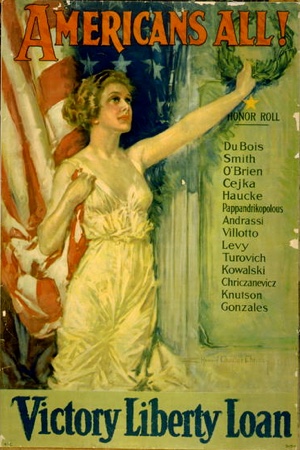America Changed Dramatically 100 Years Ago. It Was because of this War.

On April 2, 1917, President Woodrow Wilson asked Congress to declare war on Germany, and on April 6, Congress declared war against Germany. This was a major event in United States military history and led to the loss of life of over 100,000 U.S. soldiers. Yet as we commemorate the 100th anniversary of the U.S. entry into the war, we should also acknowledge the profound social effects of the war. It forced Americans to come to terms with how much their society had changed and grapple with the question of who belonged to the national community.
The war made Americans realize how much immigration had reshaped their population. Native-born troops found themselves fighting alongside immigrants from 46 nations. Officials also had to confront the religious diversity in the military. At first, the War Department asked the Protestant Young Men’s Christian Association to provide recreation services to the troops, but they received complaints from Catholics and Jews, who argued that large percentages of the soldiers, particularly the nearly 20% who were immigrants, were not Protestant. To accommodate this religious diversity, the military allowed the Knights of Columbus, and the Jewish Welfare Board to also host recreational facilities.
The War Department did a less impressive job with African-American soldiers. The Army was still segregated, and African Americans faced continual abuse and were relegated to the worst jobs, like digging latrines and removing the dead. Those who had the opportunity to fight proved their worth as soldiers, such as the infantry regiment known as the Harlem Hellfighters. They fought for 190 days and ceded no ground to the Germans. They received the French Croix de Guerre and returned as heroes.
The nation’s growing diversity also became an issue at home. Some leaders, like Theodore Roosevelt, argued that immigrants had to reject “the hyphen” and prove themselves to be “100% American.” German Americans felt the brunt of suspicion as native-born Americans went to far as to purge German words from their vocabularies. For instance, sauerkraut became known as “freedom cabbage.” Yet the Wilson administration knew that they could not alienate immigrants, and they used propaganda to promote their inclusion into American civic life. One poster (see above), titled “Americans All,” had an image of Lady Liberty and an “honor roll” of Irish, Italian, Slavic, Scandinavian and other ethnic names (although not German). Many immigrants embraced the opportunity to prove their love of the nation by enlisting in the Army, participating in Liberty Loan campaigns, and volunteering for the Red Cross.
World War I also made apparent to Americans how central women had become to their society. Over 20,000 women served as nurses during the war, and for the first time, active duty women served in other capacities, mostly clerical duties that freed men to fight. Thousands of women also went to France and worked for the YMCA and Red Cross. The women known as “Hello Girls” served as bilingual telephone operators. The Salvation Army’s “doughnut girls,” named after the treat they made for soldiers, became the most popular sight on the front. Beyond service to the military, American women on the home front took up industrial jobs in munitions factories and in other fields from which they had previously been excluded.
During this time, the decades-long fight for women’s suffrage reached a crescendo. Some women took militant action, such as when Alice Paul chained herself to the White House gates and compared Wilson’s anti-suffrage stance to the oppression of the German Kaiser. Other activists, like Elizabeth Cady Stanton, argued that wartime service proved that women deserved full civil rights. Woodrow Wilson became convinced, and on September 30, 1918, he backed women’s suffrage, declaring, “we have made partners of the women in this war…. Shall we admit them only to a partnership of suffering and sacrifice and toil and not to a partnership of privilege and right?” Congress passed the 19th Amendment a year later, and on August 18, 1920, it was finally ratified.
After the war, Americans grappled with the social changes the Great War wrought. The 1920s saw the rise of the Ku Klux Klan, but it also saw the Harlem Renaissance and the first Catholic presidential candidate—Al Smith in 1925. The organized movement for women’s political rights fell apart, but women pushed new boundaries of dress and behavior, as seen with the popularity of the flapper. Like today, the Americans of the World War I era had complex reactions to change. Some rejected it, some embraced it, and in the process of hashing it out, they continued the process of deciding who gets to participate in American civic life.